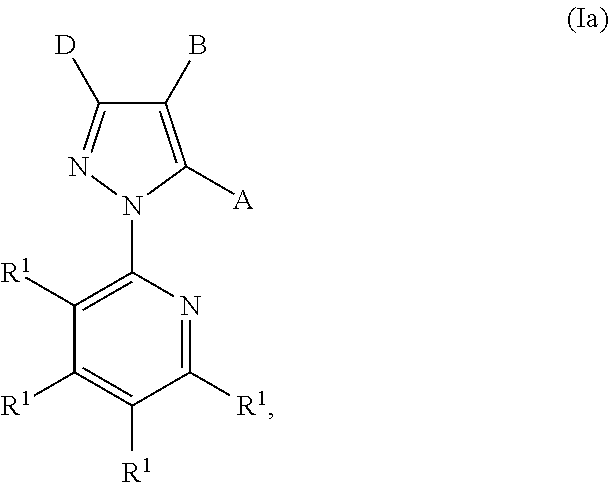Pyruvate kinase m2 modulators, therapeutic compositions and related methods of use
a pyruvate kinase and modulator technology, applied in the field of pyruvate kinase m2 modulators, therapeutic compositions, can solve the problems of loss of allosteric control of pkm2, the need for shunting biochemical intermediates, and the disease related to pyruvate kinase function, etc., to achieve the effect of modulating the level of pkm2 activity and/or glycolysis in the patien
- Summary
- Abstract
- Description
- Claims
- Application Information
AI Technical Summary
Benefits of technology
Problems solved by technology
Method used
Image
Examples
example 1
PKM2 Assay
Procedure:
[0445]PKM2 stock enzyme solution was diluted in Reaction Buffer[0446]2 μL of compound was added into each well first, and then 180 μL of the Reaction Mix was added.[0447]Reaction mixture with compound (without ADP) were incubated for 30 minutes at 4° C.[0448]Plates were re-equilibrated to room temperature prior to adding 20 μL ADP to initiate the reaction.[0449]Reaction progress was measured as changes in absorbance at 340 nm wavelength at room temperature (25° C.)
Reaction Mix:
[0450]PKM2 (50 ng / well), ADP (0.7 mM), PEP (0.15 mM), NADH (180 μM), LDH (2 units) in Reaction Buffer
Reaction Buffer:
[0451]100 mM KCl, 50 mM Tris pH 7.5, 5 mM MgCl2, 1 mM DTT, 0.03% BSA.
example 2
PKM2 Ex-Vivo Assay
[0452]Described herein is a method to measure the activity of PKM2 activators in living cells and tissue. One of ordinary skill in the art would recognize and understand that this method can be adapted to high throughput format, and can accommodate a variety of cell lines and growth conditions.
[0453]In the assay, cells are treated with a compound described herein (i.e., a PKM2 activator). This compound is capable of entering the cell and binding to PKM2, inducing an activated conformation. The excess unbound compound is washed away with PBS, and the cells are lysed by snap-freezing on dry ice, followed by addition of a detergent-containing lysis buffer. The lysate, in which activated PKM2 remains intact, is removed and added to a chemical cocktail including the chemicals necessary to measure pyruvate kinase activity, in an assay that is coupled to the LDHa enzyme. The amount of pyruvate kinase activity that is measured is normalized to the total protein content in ...
example 3
Compounds and Synthesis
[0466]
[0467]General Procedure for Compound 2:
[0468]Chlorosulfonic acid (24 mL) was added slowly over a period of 15 min to imidazole (4.0 g, 58.82 mmol) at 0° C. The resulting mixture was heated at 120-130° C. for 3 h. After completion of SM, the reaction mixture was quenched with ice cold water (25 mL) and extracted with DCM (3×40 mL). The combined organic layers were dried over Na2SO4 and concentrated under reduced pressure. The desired Compound-2 was obtained as a solid (3.0 g, 42% yield).
[0469]1H NMR (500 MHz, DMSO-d6) δ: 14.29 (bs, 1H), 8.90 (s, 1H), 7.64 (s, 1H); Mass (M+1): 166.9.
[0470]General Procedure for Compound 4:
[0471]To a solution of compound-3 (500 mg, 4.13 mmol) in DCM (10 mL) under a nitrogen atmosphere, pyridine (0.65 ml, 8.26 mmol) was added and stirred at room temperature for 15 min. The reaction mixture was then cooled to 0° C. followed by the dropwise addition of Compound-2 (820 mg, 4.96 mmol) in DCM (4 mL). The resulting reaction mixture...
PUM
 Login to View More
Login to View More Abstract
Description
Claims
Application Information
 Login to View More
Login to View More - R&D
- Intellectual Property
- Life Sciences
- Materials
- Tech Scout
- Unparalleled Data Quality
- Higher Quality Content
- 60% Fewer Hallucinations
Browse by: Latest US Patents, China's latest patents, Technical Efficacy Thesaurus, Application Domain, Technology Topic, Popular Technical Reports.
© 2025 PatSnap. All rights reserved.Legal|Privacy policy|Modern Slavery Act Transparency Statement|Sitemap|About US| Contact US: help@patsnap.com



